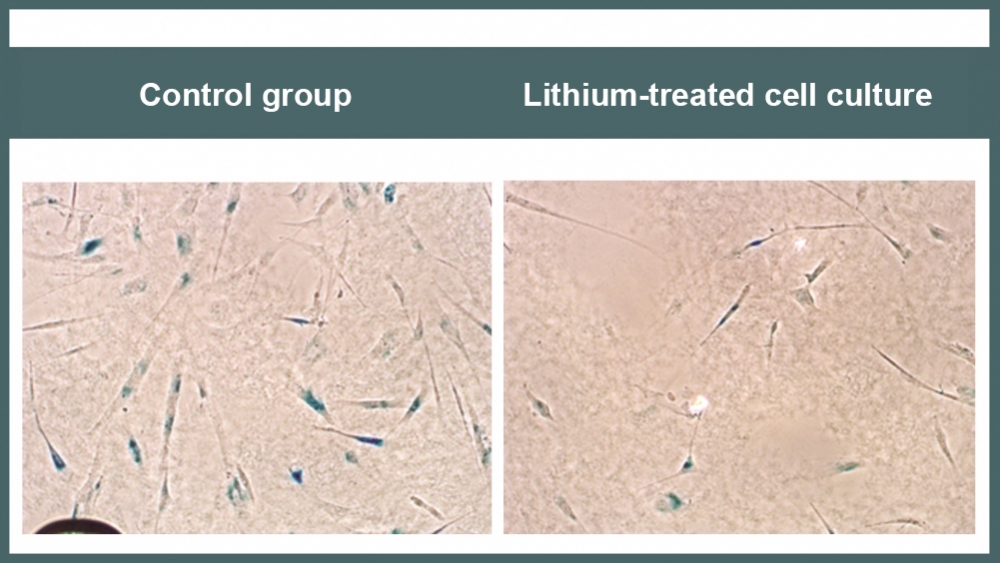

Experiments using human brain cells and mice suggest that lithium delays cellular aging, one of the factors in neurodegenerative disorders (image: astrocytes treated with lithium display fewer signs of senescence, in blue / personal archive)
Experiments using human brain cells and mice suggest that lithium delays cellular aging, one of the factors in neurodegenerative disorders.
Experiments using human brain cells and mice suggest that lithium delays cellular aging, one of the factors in neurodegenerative disorders.

Experiments using human brain cells and mice suggest that lithium delays cellular aging, one of the factors in neurodegenerative disorders (image: astrocytes treated with lithium display fewer signs of senescence, in blue / personal archive)
By André Julião in Campos de Jordão (Brazil) | Agência FAPESP – The use of lithium to combat Alzheimer’s disease has been investigated by research groups for over a decade. New findings obtained by scientists based in Brazil and the United States suggest that its beneficial effects on memory may be linked to a capacity to delay cellular aging, one of the factors underlying the development of neurodegenerative disorders. Lithium salts are often prescribed as a mood stabilizer for people with bipolar disorder and depression.
The findings were presented by Brazilian researcher Tânia Viel on September 10, 2019, during the 34th Annual Meeting of the Federation of Brazilian Societies for Experimental Biology (FeSBE) in Campos do Jordão, São Paulo State. Viel is a professor at the University of São Paulo’s School of Arts, Sciences and Humanities (EACH-USP). Part of the research was conducted while she was at the Buck Institute for Research on Aging in Novato, California, with the support of a scholarship from FAPESP.
Previous work by the group showed that when lithium is administered in very small doses, it helps conserve memory in older people with Alzheimer’s disease.
To test the effect of the drug on human brain cells, Viel used a genetic reprogramming technique that transforms adult blood cells or fibroblasts (connective tissue cells in the skin) into induced pluripotent stem cells (IPSCs), which were then led to differentiate into astrocytes, the most abundant cell type in the central nervous system.
The astrocytes were separated into two groups. One group was treated with lithium as the cells aged naturally, while no treatment was administered to the other group.
“We observed that aging was significantly reduced in the cultures that received lithium,” Viel said. “Cellular aging is one of the factors in the rise of cancer and neurodegenerative diseases such as Alzheimer’s and Parkinson’s.”
In another experiment, the scientists focused on brain functioning in senescent mice using animals bred to age in only 12 months instead of the usual 24.
“The animals treated with lithium from an early age retained their entire memory formation,” Viel said. “There’s a very clear link between increased anxiety and memory loss in old age. The reduced anxiety in the mice may be associated with memory conservation.”
Elderly patients
The results matched those of previous experiments by the same research team. The study began after the physician Marielza Nunes, a member of the group, noticed an improvement in the memory of elderly patients who took microdoses of lithium as a food supplement. Certain metals can be prescribed to correct nutritional deficiencies.
The researchers then systematized a clinical trial and selected a group of elderly patients diagnosed with Alzheimer’s disease. Half of the patients received a microdose of lithium (1.5 milligrams per day (patients with bipolar disorder are typically prescribed 60 mg per day or more)). The other half were given placebo. All were monitored for 18 months and asked to take regular memory tests.
“The memory of the patients treated with lithium stabilized from the third month on. The performance of the other group declined. The treatment was maintained for an additional period so we could be sure of the observed effect. Once we’d confirmed the difference we began giving lithium to all of them,” Viel said. The results were published in the journal Current Alzheimer Research in 2013.
The next steps in the research involve cellular models and new patient trials. Lithium will be tested in the context of the different hypotheses to explain Alzheimer’s, given that the causes of the disease are poorly understood.
In one test, brain cells will be submitted to treatment with beta-amyloid, a peptide found in patients who develop the disease. Beta-amyloid is thought to be involved in cell disorganization and to accelerate brain aging. The cells treated with beta-amyloid will receive doses of lithium to determine whether the drug can reverse the disorganization process.
In another study, researchers plan to induce aging in a cell culture using hydrogen peroxide, which is known to cause oxidative stress, a key mechanism of cell damage in aging. The goal will be to determine whether lithium can reverse this damage.
“Various kinds of brain aging can lead to Alzheimer’s. We want to see how far we can protect cells with lithium,” Viel said, recalling that previous research by the group showed that a healthy lifestyle with sufficient physical and intellectual activity protects the brain against the disease (read more at agencia.fapesp.br/29927).
In the future, groups of older people with and without Alzheimer’s disease will be tested and monitored over longer periods in an endeavor to understand the differences between them. Although genetics plays a part, people with genetic susceptibility do not always develop the disease. The researchers want to determine how the healthy brain is protected.
Republish
The Agency FAPESP licenses news via Creative Commons (CC-BY-NC-ND) so that they can be republished free of charge and in a simple way by other digital or printed vehicles. Agência FAPESP must be credited as the source of the content being republished and the name of the reporter (if any) must be attributed. Using the HMTL button below allows compliance with these rules, detailed in Digital Republishing Policy FAPESP.





